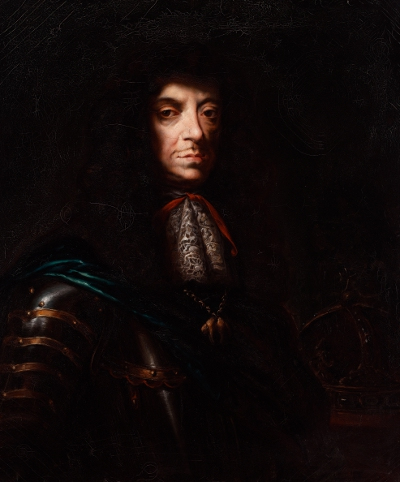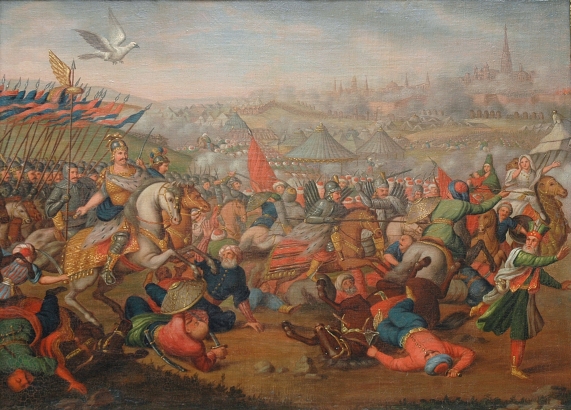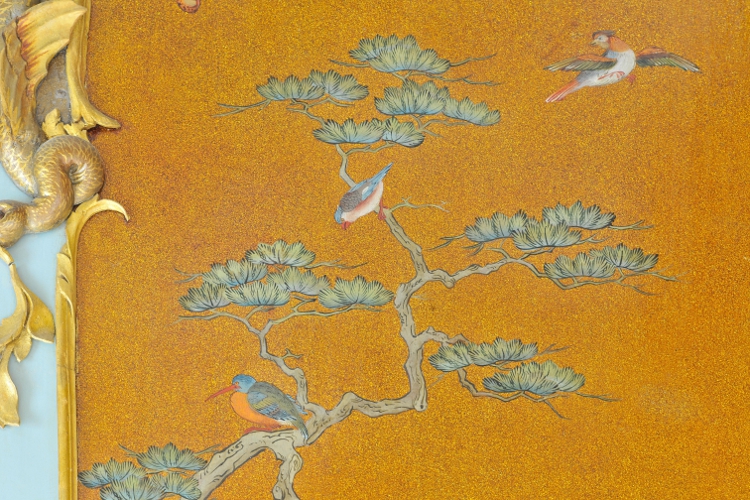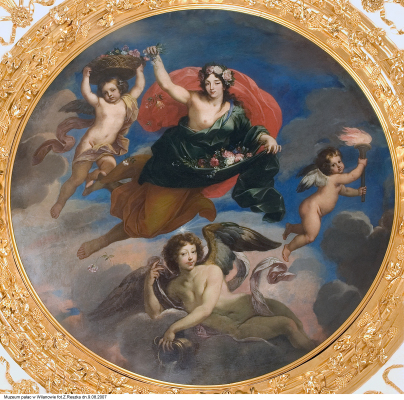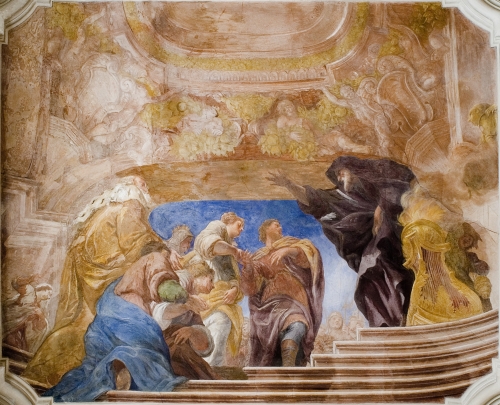Three errors beset Daniel Schultz’s introduction into the history of Baroque painting. The first — a misinformation — concerns his supposed by-name: the Younger, first mentioned in print in 1903. As archival research in Gdańsk proved, the younger Daniel (born in Gdańsk ca. 1615, died there in 1683) was related to the painter Daniel Schultz ‘the Elder’ only by name and thus cannot be seen as an heir to his older peer.
The second error resulted from a slack reading of an entry in the Metrica Regni Poloniae (Register of the Kingdom of Poland) — a record maintained by the monarch’s chancellor. Under no. 191 on both sides of page 340, one finds a document certifying Daniel Schultz’s status as a court painter. The last line of the said document states: Datum Varsauiae die X mensis Martii Anno Domini ut supra, that is, ‘given in Warsaw on 10 March, year as above’. Since documents above this entry date from 1650, Schultz could not have received his illustrious office in 1649 (as has been claimed), but in March 1650.
The third error, repeated in the painter’s biography (as late as 1971!), concerned his supposed residence in Wilanów, a result of a misidentification of the painter with Mikołaj Schulz, the royal secretary mentioned in Queen Marie Casimire’s letters to her husband. Clues traced in sources kept in Warsaw, on the other hand, suggest that the painter Daniel Schultz may have lodged at the house of royal secretary Piotr Talenti at 29 Przedzamkowa Street. During his trips to Gdańsk, on the other hand, he relied on the hospitality of mayor Adrian von der Linde, who also hosted the painter after the latter finally moved back to the city (perhaps in the 1670s?).
In the aforementioned document from March 1650, King Jan Kazimierz Waza writes that he is taking the ‘excellent’ Schultz ‘under Our royal care and protection and that he will be included and inducted among the servants and painters of Our court’, with the King noting his ‘ability to reproduce veracious likenesses greater than in other painters’. Schultz painted people as well as animals — his etched illustrations for Aesop’s tales had attracted much interest among collectors in the past — but it was his talent as a portrait painter that marked his works out from the art of the period.
Portraits of kings — Jan Kazimierz Waza, Michał Korybut Wiśniowiecki, and Jan III Sobieski, whose portraits Schultz made as part of his contract — and magnates were meant to serve a double purpose. On the one hand, they served as an effigium ad vivum of the model, depicting his outward appearance to make him instantly recognisable. At the same time, they constituted an imago of the model — an image of the monarch infused with dignity and force of personality (imperious look, gestures, attributes), designed to affect the viewer.
Most likely bowing to the tastes and desires of his subjects, Schultz employed either the western European style of portraiture — ‘an image of the monarch standing upright in an armour, rex armatus’ (composed similarly to the works of Frans Luycx) — or the traditional patterns of old Polish portraits en pied. The former is exemplified in the Portrait of King Jan Kazimierz in a Cuirass, known from a copy found in the Camaldolese church in Cracow and another, edited to half-length, found at the Royal Łazienki in Warsaw (both dating to 1659), and the Portrait of King Michał Korybut (1669, Royal Castle at Wawel). On the other hand, the Portrait of Jan Kazimierz at the Swedish castle of Gripsholm (ca. 1650) demonstrates an almost classical rendition of an old Polish portrait (the style perhaps chosen for purposes of ‘political propaganda’): the model is presented frontally, in a hieratic posture, bearing accessories highlighting his dignity and standing. Here, Schultz also adopted the firm, linear outlines in consistent tone, a feature of old Polish painting best observed in the monarch’s face but characteristically detracting from Schultz’s other works, where shapes are outlined by a soft transition of colours. Old Polish portraiture is also typified in the Portrait of Janusz Radziwiłł (ca. 1653, National Museum in Minsk), in which the Grand Hetman of Lithuania — dressed in a gilded żupan tied with a woven belt and wearing a red delia with a fur collar — is posed in a manner so similar to that of Jan Kazimierz in the portrait from Gripsholm that one might suspect conscious imitation (or the magnate’s challenge to the King).
The Gdańsk painter’s portraits of King Jan III Sobieski merit a separate mention. In 1677 Joannes Tertius Dei gratia rex Poloniae named Schultz a famous pictor Sacrae Regiae Maiestatis (Crown Register, no. 211, pages 121–2). Even earlier, though, the two met quite frequently — since 1656, when Hetman Sobieski accompanied King Jan Kazimierz in his visits to Gdańsk, and probably later, during sojourns in the city with Queen Marie Casimire, where the royal couple resided in a house spanning three parcels at the Long Market. One could also add that the King had befriended the astronomer Johannes Hevelius (for whom he acted as patron), and the scholar’s family (Hewelke) shared familial bonds with Daniel and his parents. As a monarch, King Jan III posed to numerous portraits, but Schultz’s involvement in the production of those that remain is not as easy to establish as in the case of portraits of Jan Kazimierz. The Gdańsk painter most likely enjoyed an unofficial monopoly on portraits of Jan Kazimierz, but yielded his privileges under Jan III, whose main portrait painter was Jan Tricius; the court of the time was dominated by different tastes and consequently different painters.
Two portraits of King Sobieski by Schultz have been identified. One — a full-body portrait — belonged to a collection of three portraits of Polish monarchs (Jan Kazimierz, Michał Korybut, and Jan III) ordered by the Gdańsk city council for the Town Hall interiors (a probable replica or copy, measuring 152 by 73cm, was the subject of an auction in Gdańsk in 1771). The portraits were lost during the taking of Gdańsk by Prussia in 1793. The second portrait of Sobieski in Gdańsk that archival sources attribute to Schultz was found at the Royal Chapel, which the King contributed to raising in 1678–81 (the assumed time of the creation of the work). According to a description by Willy Drost from 1959, the painting was a head-and-shoulders portrait with the model dressed in a silver corazzina and wearing a red delia with a fur collar, fastened with a decorative brooch. It is said that the painting remained in its intended location until World War II, but its history is inconsistently and hazily described in literature. There is much to suggest that Daniel Schultz’s painting from the Royal Chapel served as a kind of prototype for numerous head-and-shoulders depictions of King Jan III. In my opinion, among the numerous duplications, the portrait of Sobieski in the Museum of the Polish Armed Forces in Warsaw (owned by the National Museum in Warsaw, inv. no. 477, 82 by 66.3cm) is distinguished by a trace of the spirit of the original work. The warped positioning of the eyes suggests that the portrait was copied from a prototype, but in the brushwork of the copy — corrected (!) by conservators — I observed a strand of the naturalist tendency characteristic for Schultz’s portraits: the disfiguring of facial features by folds of sagging skin, tiredness, a look of distaste (?). Two similar portraits of the King — one in the collection at Wawel (Royal Castle at Wawel, inv. no. 4664, 87.5 by 72cm), the other in Bavaria (Munich, Bayerische Staatsgemäldesammlungen Inv.Nr. 7551, 76.5 by 62cm) — bear traces of Schultz’s characteristic outlining of the face, but their linearity and ‘sculptural’ modelling preclude a straightforward attribution.
It is not known whether Schultz practised in any of the Gdańsk workshops, but the deficiencies in his drawing from a model seem to suggest he did not. It is certain that he perfected his abilities in the Netherlands, a popular destination for would-be painters from northern Europe. This is formally certified by a matriculation entry at the University of Leiden dating from 1643 (students enjoyed certain privileges), but the Dutch education is primarily visible in the Gdańsk-born artist’s paintings. For the finest illustrations of Schultz’s adaptation of the Flemish lesson in his works, one should look to the portraits of František Karel I Libštejnský of Kolovrat and his wife Magdalena Ludmila née von Oppersdorf (1659, Kolovrat Castle in Rychnov, Czech Republic) and that of Konstanze von Holten-Schumann, which adorns the gallery of the National Museum in Gdańsk (painted between 1670 and 1680). For these paintings, Schultz adopted the northern style of portraiture, which did not distinguish between burghers and noblemen. The elegance of these portraits — as of those of Flemish aristocrats and wealthiest patricians — is highlighted in the uncommonly exquisite clothing, refined gestures and the colouring of the faces. The countenances of Libštejnskýs and Schumann are pale, completed with a greyish-tinted glaze, as if Schultz was trying to approximate the paleness of the figures painted by Antoon van Dyck, a signifier of genteelness. The third edition of graphical portraits based on the master’s drawings, Icones Principorum Virorum, had been making waves in Antwerp since 1645, that is, exactly during the period of Schultz’s formation as a painter in the city. In spite of the realism of posture and appearance, the faces of Libštejnskýs and Schumann are grave, without even a ghost of a smile. Whether Schultz appropriated this feature from his readings of the Dutch theory of art — which considered smiles inadmissible in portraiture — or from the works of Dutch and Flemish masters he had studied, is unknown. The artist shaped the faces of his models in a similar manner in many of his works, for instance in a vivid, but also somewhat unreal — due to excessive seriousness and greyish tones — depiction of Bishop Andrzej Trzebicki (1664, Cracow, Franciscan monastery).
The fruits of studying the works of Dutch painters are evident in the Portrait of Dedesh Aga with Entourage (1664, Saint Petersburg’s Hermitage). Here, Schultz shapes the face more by indefinite patches of coloured tones than through lines (e.g. the eye sockets of the sad page, the shag of the spaniel, the plump face of the youngster with the falcon), suggestive of a fascination with Flemish portraits. On the other hand, Schultz would not have been able to render so brutally the senile, sagging eyelids or the web of wrinkles around Dedesh’s lips if it was not for his experiences with Dutch naturalism. Furthermore, while the envoy and his men are clothed in Polish garb befitting their function, Schultz portrayed them in a manner patterned on the patrician models of Dutchman Bartholomeus van Helst. Astronomer Hevelius also posed for his kinsman Schultz in an elegant robe de chambre which, according to western European customs, befitted elevated personages.
In spite of their variety, all Schultz’s portraits share a common quality — his ability to penetrate into the psyche of the model. It is not merely incidental that scholars of Schultz’s oeuvre are so prone to employ near-literary phrases: ‘the weary and pained expressions of Jan Kazimierz’, ‘the face of Dobrogost [Stanisław] Krasiński, shrouded in grief’, ‘the secretly passionate Konstanze Schumann’, the ‘cold stare’ of bishop Trzebicki. ‘The gaze [of Krzysztof Pac] betraying the player’s disbelief’, the look of ‘a cunning poker player’ (on the diplomat Dedesh), ‘bitter monarch, worn down by the sorrows of his rule’ (on King Jan Kazimierz from the portrait at Łazienki in Warsaw). This was not an ability Schultz could have learned, but rather a feature of his own psychology, his attitude, his individual approach to the models.
Dutch fascinations may be even more evident in Schultz’s paintings of animals than in his portraits. The painter’s Dutch sojourn is assumed to have taken place in the 1640s, a period of major success of local masters such as Gijsbert and Melchior de Hondecoeter, the innovative Frans Snyders, his student Paul de Vos, and Snyders’ competitor, Adriaen van Utrecht.
Schultz’s turn toward a theme so unusual for painters in our region (he enjoyed an undisputed primacy ever since animal painter Carl Ruthart left Gdańsk in the 1650s) may have stemmed from having witnessed the popularity such works enjoyed in the Netherlands, a likely motivation for trying his luck in a genre that would make an easy sell. He could also have been enthralled by the ways in which Dutch animal painters expressed movement of animals in space on a flat canvas, in the colourful plumage or fur. Another reason may have been the fact that paintings on religious and ancient themes (or, figural) were not Schultz’s strongest suit given that he had no training in drawing from a model, this ‘basic grammar of painting’.
Only six of Schultz’s paintings on animal themes remain — Still Life with Spoils from the Palazzo Pitti in Florence (1646), four paintings at the National Museum in Gdańsk: Duck Hunt (1658), Three Foxes (1660), Cock Defending His Hens (after 1660), and Fox and Grapes (1648, recovered by Poland in 2010), and Birds’ Yard I (after 1660, formerly in Gdańsk, currently in the Pushkin Museum in Moscow). Besides those works, there are four etchings (in several collections), probably intended as illustrations for an edition of Aesop’s fables (The Bird in Borrowed Feathers, The Cat and the Birds, Birds’ Yard, Cock, Hens, and Falcon, all dating to the 1650s). Without a doubt, more such works had existed, a fact proven by mentions of at least a few others. It should also be added that both the Allegory of Autumn (1660s, Stockholm Nationalmuseum) and the Portrait of a Nobleman Holding a Hare (1660s, National Museum in Wrocław) invoke animal themes.
Both in his paintings and etchings, the painter seems to prefer settings with birds, perhaps due to the fact that their immobility makes them easier to animate than mammals with their complex movements (another reason which I personally find convincing might be the birds’ more gentle appearance than that of furry animals with their brutal fights).
The anthropomorphism of animal stories and story-telling settings are features Schultz most likely appropriated primarily from the works of Snyders. The varied activities of the fowl society depicted in Schultz’s drawings and etchings often correspond to particular fables of Aesop — a fashionable read in the seventeenth century, particularly in Lutheran circles (Martin Luther attached great importance to the moral aspect of the fables and even translated thirteen of them himself). Schultz’s fascination with Snyders’ art and its impact inform his Flemish directness and focus on sheeny furs or feathers, as in Cock Defending His Hens, where the combination of gold and silvery-white spots, glazed to reflect light from the side, forms the centrepiece of the composition. Of his direct adaptations of other masters’ works, Schultz’s Three Foxes from 1660 serves as a rather clumsy paraphrase of Snyders’ Fox and Wild Cats (late 1610s, previously at the Museum in Aachen, now lost). At the same time, though, even this work exemplifies Schultz’s sensitivity to colour and his use thereof in shaping contours without resorting to lines.
One might be tempted to reconstruct an image of Daniel Schultz from the scant and indirect mentions in sources, mostly concerning financial matters. He was a wealthy man; the document that names him among the King’s servants mentions a yearly salary of 400 imperial thalers — which, according to calculations from different historians, amounted to 1076 or 1200 złotys (or florins), an amount that in 1650 would buy the artist around 19 oxen or four and a half horses. In the same period, a scribe at the Warsaw city council earned 600 złotys/florins a year, while professors of law and history at the famous Academic Gymnasium in Gdańsk received a yearly pay of 900 złotys/florins. Comparisons to earnings of contemporary painters in the Netherlands also tend to favour Schultz. Whatever method of approximation is employed, the results undeniably prove that Schultz’s salary was high, perhaps because it included the ‘portrait service’ to the royal couple and other persons named by the King. Schultz’s earnings also included royalties for portraits ordered by patrons other than the King. Besides, the registry of the Gdańsk Kamlaria (municipal finance office) indicates that Schultz lent — or invested — sums (e.g. 3000 florins in 1678) to the city treasury, profiting on interest.
Daniel Schultz never married or fathered children (he bequeathed his whole estate to his half-sister Anna Gödecke), which suggests that he multiplied his wealth for his own — perhaps excessive — needs. It might be assumed that Schultz did not own a house, since as late as 1677, that is, six years before falling ill and dying, he lived at Adrian de Linde’s (domum lapideam generosi Adriani de Linda) at today’s Ogarna Street. It was an address ‘at the very top of the social ladder’; in his youth, mayor Linde was a page at the court of Władysław IV, and later was nominated the royal burgrave in Gdańsk eight times, became a patron of the arts, and collected books. Another patrician — a brewer, the father of Daniel’s stepfather — also owned a house by the same street. Adrian de Linde is not the only personage mentioned in sources in relation to Daniel Schultz. The secretary to Queen Marie Louise received commendations for Daniel from his kinsman, the world-famous Hevelius; in Warsaw, the painter befriended King’s secretary Talenti and his wife; meanwhile, the context of the source from 1677 also suggests a friendship with Chancellor Krzysztof Pac. Prominent burghers of Gdańsk were named as witnesses in Schultz’s final will: councillor Michael Gödecke, physician and city physicist Johann Schmid, and Johann Nixdorf, a learned jurist.
Thus, Daniel Schultz outgrew his colleagues from the guild — not only due to his background in the wealthy bourgeoisie (his father was a major brewer) or the privileged position of a royal servant, which freed him from obedience to the rules of the painters’ guild and from civic jurisdiction in Warsaw and Gdańsk. His social status certainly marked him out from among his fellow painters. A mainstay at the court in the capital, friend to the most esteemed patricians of the Free City, the wealthy painter Daniel Schultz represents a model of the modern artist, one for whom the designation from his official nomination as a court painter — ‘camerae Nostrae servitore’ — was a monarchic anachronism.
Bibliography
A.Z. Helcel, Listy Jana Sobieskiego, Kraków 1860.
N. von Holst, ‘Danziger Kunstkabinette und Kunsthandelsbeziehungen im 18. Jahrhundert.’, Mitteilungen des Westpreussischen Geschichsvereines 33 (1910).
G. Cuny, ‘Der Danziger Maler Daniel Schultz’, Monatshefte für Kunstwissenschaft (1915), p. 1–9.
W. Drost, ‘Kunstdenkmäler der Stadt Danzig’, in: Bau- und Kunstdenkmäler des deutschen Ostens, Vol. 3, Stuttgart 1959.
L. Thijssen, 1000 Jaar Polen en Nederland, Zutphen 1992.
J. Pelc, Ceny Gdańska XVI–XVII w., Lwów 1937.
A. Mikołajczyk, Leksykon numizmatyczny, Warszawa 1994.
B. Steinborn, ‘Rytownik Daniel Schultz’ in: Arx Felicitatis. Księga ku czci Profesora Andrzeja Rottermunda w sześćdziesiąta rocznicę urodzin, Warszawa 2001, p. 199–206.
B. Steinborn, ‘Znajomi i finanse Daniela Schultza’, Barok 1–2 (2002), p. 65–73.
B. Steinborn, ‘Szkic do życiorysu gdańskiego malarza Daniela Schultza’, Zapiski Historyczne 68 (2003), no. 1, p. 19–36.
B. Steinborn, ‘Portretowanie Daniela Schultza’, in: Gdańsk dla Rzeczypospolitej w służbie Króla i Kościoła (exhibition catalogue), Muzeum Historyczne miasta Gdańska, Warszawa 2004, p. 77–83.
B. Steinborn, Malarz Daniel Schultz, Gdańszczanin w służbie królów polskich, Warszawa 2004.
B. Steinborn, ‘Raz jeszcze o Portrecie agi Dedesza ze świtą, dziele Daniela Schultza’, in: Mowa i moc obrazów. Prace dedykowane profesor Marii Poprzęckiej, Warszawa 2005, p. 136–142.
Translation: Antoni Górny
